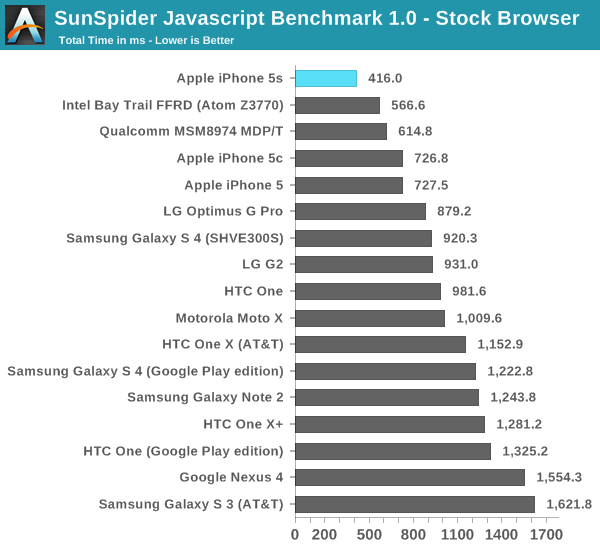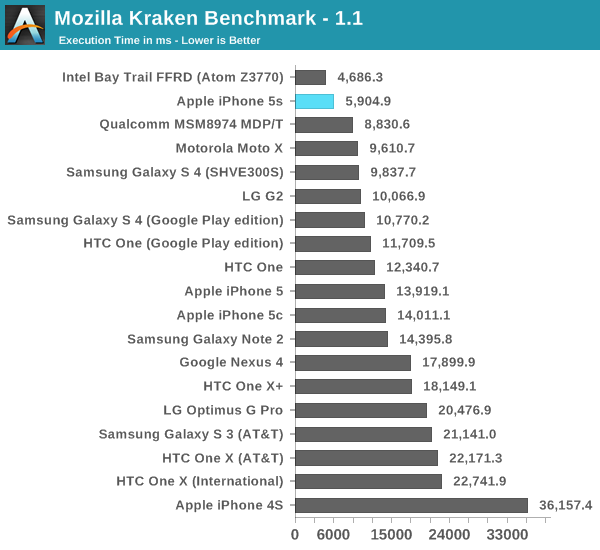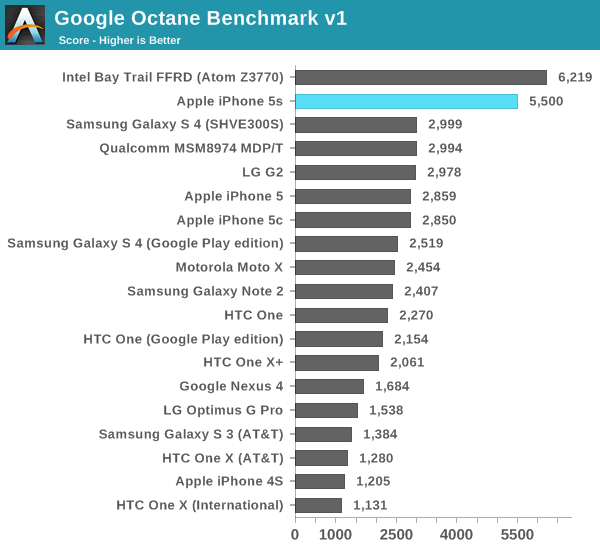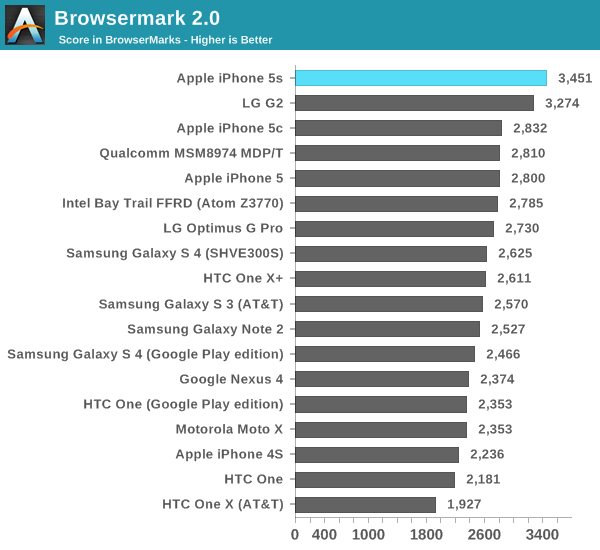The iPhone 5s Review
by Anand Lal Shimpi on September 17, 2013 9:01 PM EST- Posted in
- Smartphones
- Apple
- Mobile
- iPhone
- iPhone 5S
CPU Performance
For our cross-platform CPU performance tests we turn to the usual collection of Javascript and HTML5 based browser tests. Most of our comparison targets here are smartphones with two exceptions: Intel's Bay Trail FFRD and Qualcomm's MSM8974 Snapdragon 800 MDP/T. Both of those platforms are test tablets, leveraging higher TDP silicon in a tablet form factor. The gap between the TDP of Apple's A7 and those two SoCs isn't huge, but there is a gap. I only include those platforms as a reference point. As you're about to see, the work that Apple has put into the A7 makes the iPhone 5s performance competitive with both. In many cases the A7 delivers better performance than one or both of them. A truly competitive A7 here also gives an early indication of the baseline to expect from the next-generation iPad.
We start with SunSpider's latest iteration, measuring the performance of the browser's js engine as well as the underlying hardware. It's possible to get good performance gains by exploiting advantages in both hardware and software here. As of late SunSpider has turned into a bit of a serious optimization target for all browser and hardware vendors, but it can be a good measure of an improving memory subsystem assuming the software doesn't get in the way of the hardware.

Bay Trail's performance crown lasted all of a week, and even less than that if you count when we actually ran this benchmark. The dual-core A7 is now the fastest SoC we've tested under SunSpider, even outpacing Qualcomm's Snapdragon 800 and ARM's Cortex A15. Apple doesn't quite hit the 2x increase in CPU performance here, but it's very close at a 75% perf increase compared to the iPhone 5. Update: Intel responded with a Bay Trail run under IE11, which comes in at 329.6 ms.
Next up is Kraken, a heavier js benchmark designed to stress more forward looking algorithms. Once again we run the risk of the benchmark becoming an optimization target, but in the case of Kraken I haven't seen too much attention paid to it. I hope it continues to fly under the radar as I've liked it as a benchmark thus far.

The A7 falls second only to Intel's Atom Z3770. Although I haven't yet published these results, the 5s performs very similarly to an Atom Z3740 - a more modestly clocked Bay Trail SKU from Intel. Given the relatively low CPU frequency I'm not at all surprised that the A7 can't compete with the fastest Bay Trail but instead is better matched for a middle of the road SKU. Either way, A7's performance here is downright amazing. Once again there's a performance advantage over Snapdragon 800 and Cortex A15, both running at much higher peak frequencies (and likely higher power levels too, although that's speculation until we can tear down an S800 platform and a 5s to compare).
Compared to the iPhone 5, the 5s shows up at over 2.3x the speed of last year's flagship.
Next up is Google's Octane benchmark, yet another js test but this time really used as a design target for Google's own V8 js engine. Devices that can run Chrome tend to do the best here, potentially putting the 5s at a disadvantage.

Bay Trail takes the lead here once again, but again I expect the Z3740 to be a closer match for the A7 in the 5s at least (it remains to be seen how high the iPad 5 version of Cyclone will be clocked). The performance advantage over the iPhone 5 is a staggering 92%, and obviously there are big gains over all of the competing ARM based CPU architectures. Apple is benefitting slightly from Mobile Safari being a 64-bit binary, however I don't know if it's actually getting any benefit other than access to increased register space.
Our final browser test is arguably the most interesting. Rather than focusing on js code snippets, Browsermark 2.0 attempts to be a more holistic browser benchmark. The result is much less peaky performance and a better view at the sort of moderate gains you'd see in actual usage.

There's a fair amount of clustering around 2500 with very little differentiation between a lot of the devices. The unique standouts are the Snapdragon 800 based G2 from LG, and of course the iPhone 5s. Here we see the most modest example of the A7's performance superiority at roughly 25% better than the iPhone 5. Not to understate the performance of the iPhone 5s, but depending on workload you'll see a wide range of performance improvements.










464 Comments
View All Comments
BrooksT - Wednesday, September 18, 2013 - link
Nobody will disagree because you've completely destroyed your credibility by insulting the credibility, integrity, and competence of the reviewer, the site, and Apple because the evidence doesn't conform to your speculations and bias. You are not to be taken seriously, and at this point I think everyone sees that.Post evidence of this conspiracy or STFU.
ddriver - Thursday, September 19, 2013 - link
How a whiff of reality for you - my credibility is and has not been on the line on this one. You don't know who I am, you don't know my credentials. This is not the case for Anand, even if I am right he is not in the position to admit to compiling the review in a manner that creates an unrealistically good presentation of a product, because unlike for me, that would be a huge credibility calamity for him. If anything, his responses are very "political" carefully dancing around the pivot points of my concerns. While his response did partially bring light to a few of my concerns, my key points remain valid - the article continues to not compare A7 with ARMv7 head to head in the sole native CPU benchmark present in the article, "CPU performance" was not renamed to JS performance or moved to browser performance or something like that. See, just because he didn't agree with my points and admit to being biased does not mean I am wrong and that is not the case, considering he is not in the position to do that. I didn't really expect anything more or less than the same "carefully dancing" answer as the article itself, my main motivation was to show him that not all AT readers are incapable of reading between the lines, for the sake of future articles, I did not expect that he would make any revision to the article at hand. Honesty is for those who have nothing to lose, and while his credibility is no the line, my isn't, make the conclusions, if you can ;)CyberAngel - Thursday, September 19, 2013 - link
Don't worry! I believe you...conditionally!I put it this way: I greatly doubt that the tests would reveal any points that are less than favorable the Apple. ANY company would do the same: promote the best parts and highlight the strength of the product.
akdj - Thursday, September 19, 2013 - link
"You don't know who I am, you don't know my credentials."I'm not sure anyone here is interested---you've already made clear you're a conspiracy theorist, that you believe Apple is paying off reviewers, that you disrespect folks MUCH more intelligent than yourself when it comes to chip architecture...and that your "main motivation was (Is) to show him that not all AT readers are incapable of reading between the lines". You've shown NO one ANYthing substantiated. You continue to argue baseless facts and accuse respected individuals and groups/teams of intelligent members of being bias towards Apple. Nothing in this review supports your claims---NOTHING! And, as I pointed out earlier---even the biggest anti-apple sites are applauding Apple's efforts with this SoC effort.
You're in the minority---and to be so vain that we would care about who you are and what your credentials are is silly. It sounds to me like you're a 17 year old with a decent vocabulary and not enough paper in the pocket to pick up an iPhone 5s for yourself. But...what do I know. I don't know you, your credentials...or how you lean politically, nor do I care.
IMO---you're an insult to the entire Anand crew. I'm not sure why I continue to read your responses, they're all the same, just worded differently. Again...you're in the (extreme) minority. You're certainly not an engineer, chip designer, app developer or technological guru---if you were, you would understand the feat Apple has achieved with this SoC architecture.
J
Nurenthapa - Friday, September 20, 2013 - link
I've been enjoying reading this in China, but you, sir, are really annoying me with your sniveling drivel. You have an axe to grind and simply won't shut up. Hope you disappear from this forum. BTW, I use a HTC One and iPad 2, and occasionally my old original 2007 iPhone. I love IOS and iPhones, but won't be buying one until they come out with a somewhat bigger screen.oryades - Wednesday, September 18, 2013 - link
Intel, now Apple, the same featured reviews.edward kuebler - Wednesday, September 18, 2013 - link
We are talking about 64 bits too much. The story is new instruction set in ARMv8. Instead complicating the hardware for backwards compatibility (e.g. look at x86 still supporting 16bit code) they wrote a new instruction set faster and less energy demanding. There is still ARMv7 compatibility, but the 64bit mode is independent. And the thing is, once you redesign your architecture, why not go 64bit? what´s the point of staying 32 bit? Moving more data is both slower and faster. More and wider registers help compiler optimizations and media decoding. I didn't get all this “cunning deceitful conspiracy” feeling you talk about. Staying in 32 bit land, *that* would keep me guessing.Anand Lal Shimpi - Wednesday, September 18, 2013 - link
Our browser based suite (stressing js/HTML5 and other browser based workloads) remains unchanged from all of the other mobile SoC reviews we've done. There's no way of getting around the software differences on these mobile devices as you buy hardware+software together. Unfortunately it's still our best option for non-GPU cross platform comparisons, there just aren't many good cross platform CPU tests.I called out the inclusion of hardware accelerated AES/SHA when referencing those tests, there were no attempts to hide that fact. The fact remains that those algorithms will see a speedup on ARMv8 hardware because of those instructions. Note this is no different than when we run the TrueCrypt benchmarks on AES-NI enabled processors vs. those that don't have it (e.g. http://images.anandtech.com/graphs/graph5626/44765...
Apple provided absolutely zero guidelines on how the review was to be conducted. The only stipulations were around making sure we didn't disclose the fact that we had devices. In fact, most manufacturers don't - at least not with us. Whenever there are any stipulations presented, we always disclose them on the site (e.g. see our early look at Trinity desktop performance).
Krait implements ARMv7, so that's 64-bit wide registers for its NEON units. It expanded the width of the execution units, but the registers themselves have to adhere to the ARMv7 ISA.
I think we explained why 64-bit makes sense (doing so at the last minute doesn't make sense, immediate SIMD/Crypto perf increases today, and helps build up the ecosystem), and even highlighted cases where a performance degradation does happen (see: Dijkstra tests). Keep in mind that iOS has always erred on the side of being more thrifty with RAM to begin with. I would like to see more but I don't know how necessary it is today.
Take care,
Anand
ddriver - Wednesday, September 18, 2013 - link
Anand, maybe you should hire a developer to write native cross platform benchmark tools. This is the only way to avoid all caveats like sponsored exclusive optimizations, different implementations, eliminate unrealistic low footprint synthetics, "selective compilers" (*cough Intel*) and whatnot. Considering the amount of reviews you are doing and the fact that C/C++ compilers have caught up with ARM for a long time, this is nothing hard and something that entirely makes sense, especially relative to using different JS engine implementations to measure CPU performance. JS should go in the "browser" department, not CPU performance.According to wikipedia, Krait implements 128bit SIMD, so maybe that is a mistake on wikipedia's behalf?
I still think encryption results belong in their own chart, and have no place in a chart that is supposed to be indicative of the integer performance delta between 32 and 64bit execution modes. Even with the clarification you made, it creates an unrealistic impression, not to mention some people skimp over the text and only look at the numbers. Encryption is encryption, integer performance is integer performance. Why mix the two (except for the reason I already mentioned and you deny)?
I wish you'd reflected a bit on the marketing aspect of the transition to 64, considering how much apple is riding it this time around. No one argues 64bit is good and more performance is good, but this brings up the issue of the particular implementation, e.g. a fast chip with only a single gigabyte of ram, and how will that play out with an actual performance demanding real world application.
Thanks for addressing my concerns.
Wilco1 - Wednesday, September 18, 2013 - link
ARMv7 has 32 64-bit SIMD registers but they can also be used as 16 128-bit SIMD registers. Modern CPUs like Cortex-A15 and Krait support many 128-bit SIMD operations in a single cycle, but not all operations are supported (such as double precision FP). ARMv8 has 32 128-bit SIMD registers and supports SIMD of 2 64-bit doubles.